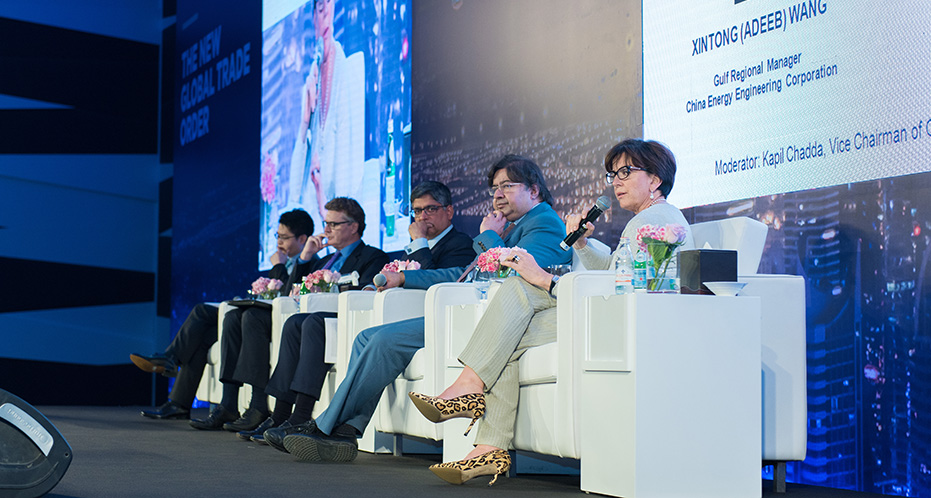Driving commercial and political engagement between Asia, the Middle East and Europe
Driving commercial and political engagement between Asia, the Middle East and Europe
Driving commercial and political engagement between Asia, the Middle East and Europe

China’s Belt and Road Initiative (BRI) is rarely out of the news. From its geopolitical implications to the huge business opportunities it presents, the ambitious infrastructure programme remains one of the hottest issues in global trade and investment. It was therefore a key talking point at the Asia House trade dialogue in Dubai – The New Global Trade Order.
“Through the Belt and Road Initiative, China is seeking to build trading infrastructure connecting some 65 per cent of the world’s population,” Michael Lawrence, Chief Executive of Asia House, said as he introduced a panel discussion on the BRI at the conference.
“China itself estimates that its trade with countries on the Belt and Road will top US$2.5 trillion annually within the next ten years.”
Despite the ambitious scale of the project, the BRI remains an ambiguous entity. For Ravi Suri, Global Head of Infrastructure Finance, KPMG, this has given rise to “three myths” about the BRI that must be overcome if investors are to realise the project’s potential.
The BRI is not “some kind of a Marshall Plan,” nor is it aimed at China controlling natural resources around the world, he said. But the third, and most important myth, is that the BRI is “an initiative of policy banks of China to lend to state governments.” It isn’t, Suri asserted. Rather, it’s about getting private capital in. “If you can address the private capital issue than you will be able to address the concerns of the IMF” and other critics of the BRI, Suri said.
Middle East perspective
The Middle East is particularly important to the BRI, being both crucial to Chinese energy security and occupying a strategic position on the Maritime Silk Road. Panel moderator Kapil Chadda, Vice Chairman, Global Banking, Middle East and North Africa & Turkey, HSBC Bank Middle East, was therefore interested to know how BRI is playing out in the region.
“Energy is clearly a theme here,” Neil Cuthbert, Partner, Dentons & Co, said, outlining a number of recent BRI deals involving energy companies across the UAE and Saudi Arabia.
“Governments around the region are looking to attract more foreign investment,” Cuthbert said, highlighting an increasing interest in Public Private Partnerships and associated legislation. This model, which sees Chinese contractors become “active investors” with a major stake in projects, could be the future direction of travel.
“Chinese companies coming in and investing is definitely one of the ways which we’re seeing most regional governments talk about as a way of bringing in foreign capital,” Cuthbert added.
Opportunities for developed markets
The conditions in the Middle East also present opportunities for non-Chinese companies looking to capitalise on the BRI, said Xitong Wang, Gulf Regional Manager, China Energy Engineering Company.
“If you want to increase your investment you should be aware of challenges and obstacles here,” he said. These challenges include “how to mitigate risk and how to structure your financing model here.”
These are “still challenging for Chinese companies,” which are “still inexperienced” in these areas, Wang said. “There is need to collaborate with international players, not just developers, but international law firms, international consultation firms and the banks, so we become more skilled and more prepared for the competition and risk in GCC countries.”
This would indicate major opportunities for these sectors in developed economies.
Policy perspective
The BRI has, of course, raised new questions about China’s leadership role in the global order, and what Beijing’s ultimate aims are through the programme. It is also likely to push policy positions in the Middle East. This was something Anne Ruth Herkes, Former State Secretary at the German Federal Ministry for Economic Affairs and Energy, picked up on.
“We are still waiting for China to tell us what its position is on global leadership and on global governance beyond its strict commercial resource and other needs,” she said. In terms of specifics, Herkes predicted that the BRI “could be a driving force behind more energy integration, more integrated trade routes, gas pipelines and electricity transmission,” but that the EU and GCC have a role to play in ensuring the BRI brings a net positive.
“I think we will be winning this game if the Middle East Gulf Cooperation Council and the European Union converge on giving the initiative its right interpretation. It’s an opportunity for us in Europe and the GCC to grasp, and turn into a positive agenda.”
For Suri, that shouldn’t be too difficult.
“The Belt and Road Initiative is not only a good thing. It’s an excellent thing. It’s an excellent thing for the world,” he said.
The New Global Trade Order conference took place in Dubai as part of the Asia House Middle East Programme. The conference was sponsored by HSBC.
